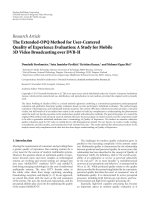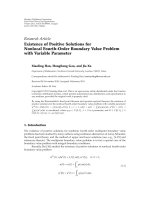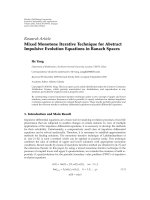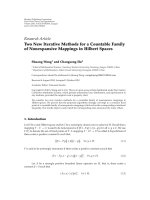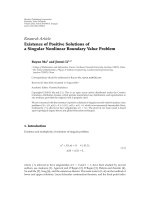Báo cáo hóa học: " Research Article The Monotone Iterative Technique for Three-Point Second-Order Integrodifferential Boundary Value Problems with p-Laplacian" pptx
Bạn đang xem bản rút gọn của tài liệu. Xem và tải ngay bản đầy đủ của tài liệu tại đây (502.65 KB, 9 trang )
Hindawi Publishing Corporation
Boundary Value Problems
Volume 2007, Article ID 57481, 9 pages
doi:10.1155/2007/57481
Research Article
The Monotone Iterative Technique for Three-Point Second-Order
Integrodifferential Boundary Value Problems with p-Laplacian
Bashir Ahmad and Juan J. Nieto
Received 18 December 2006; Revised 1 February 2007; Accepted 23 April 2007
Recommended by Donal O’Regan
A monotone iterative technique is applied to prove the existence of the extremal positive
pseudosymmetric solutions for a three-point second-order p-Laplacian integrodifferen-
tial boundary value problem.
Copyright © 2007 B. Ahmad and J. J. Nieto. This is an open access article distributed un-
der the Creative Commons Attribution License, which permits unrestricted use, distri-
bution, and reproduction in any medium, provided the original work is properly cited.
1. Introduction
Investigation of positive solutions of multipoint second-order ordinary boundary value
problems, initiated by Il’in and Moiseev [1, 2], has b een extensively addressed by many
authors, for instance, see [3–6]. Multipoint problems refer to a different family of bound-
ary conditions in the study of disconjugacy theory [7]. Recently, Eloe and Ahmad [8]
addressed a nonlinear nth-order BVP with nonlocal conditions. Also, there has been a
considerable attention on p-Laplacian BVPs [9–18]asp-Laplacian appears in the study
of flow through porous media (p
= 3/2), nonlinear elasticity (p ≥ 2), glaciology (1 ≤ p ≤
4/3), and so forth.
In this paper, we develop a monotone iterative technique to prove the existence of
extremal positive pseudosymmetric solutions for the following three-point second-order
p-Laplacian integrodifferential boundary value problem (BVP):
ψ
p
x
(t)
+ a(t)
f
t,x(t)
+
(1+η)/2
t
K
t,ζ,x(ζ)
dζ
=
0, t ∈ (0,1),
x(0)
= 0, x(η) = x(1), 0 <η<1,
(1.1)
where p>1, ψ
p
(s) = s|s|
p−2
.Letψ
q
be the inverse of ψ
p
.
2 Boundary Value Problems
In passing, we note that the monotone iterative technique developed in this paper is
an application of Amann’s method [19] and the first term of the iterative scheme may be
taken to be a constant function or a simple function. The details of the monotone iter-
ative method can be found in [20–27] and for the abstract monotone iterative method,
see [28, 29]. To the best of the authors’ knowledge, this is the first paper dealing with the
integrodifferential equations in the present configuration. In fact, this work is motivated
by [11, 17, 18]. The importance of the work lies in the fact that integrodifferential equa-
tions are encountered in many areas of science where it is necessary to take into account
aftereffect or delay. Especial ly, models possessing hereditary properties are descr ibed by
integrodifferential equations in practice. Also, the governing equations in the problems of
biological sciences such as spreading of disease by the dispersal of infectious individuals,
the reaction-diffusion models in ecology to estimate the speed of invasion, and so forth
are integrodifferential equations.
2. Terminology and preliminaries
Let E
= C[0,1] be the Banach space equipped with norm x=max
0≤t≤1
|x(t)| and let
P be a cone in E defined by P
={x ∈ E : x is nonnegative, concave on [0,1], and pseu-
dosymmetric about (1 + η)/2 on [0,1]
}.
Definit ion 2.1. A functional γ
∈ E is said to be concave on [0,1] if γ(tu +(1− t)v) ≥
tγ(u)+(1− t)γ(v), for all u,v ∈ [0,1] and t ∈ [0,1].
Definit ion 2.2. A function x
∈ E is said to be pseudosymmetric about (1 + η)/2 on [0,1]
if x is symmetric over the interval [η,1], that is, x(t)
= x(1 − (t − η)) for t ∈ [η,1].
Throughout the paper, it is assumed that
(A
1
) f : [0,1] × [0,∞) → [0,∞) is continuous nondecreasing in x,andforanyfixed
x
∈ [0,∞), f (t,x) is pseudosymmetric in t about (1 + η)/2 on (0,1);
(A
2
) K : [0,1] × [0,1] × [0,∞) → [0,∞)iscontinuousnondecreasinginx,andforany
fixed (ζ,x)
∈ [0,1] × [0,∞), K(t,ζ,x) is pseudosymmetric in t about (1 + η)/2on
(0,1);
(A
3
) a(t) ∈ L(0,1) is nonnegative on (0,1) and pseudosymmetric in t about (1 + η)/2
on (0, 1). Further, a(t) is not identically zero on any nontr ivial compact subin-
terval of (0,1).
Lemma 2.3. Any x
∈ P satisfies the following properties:
(i) x(t)
≥ 2(1 +η)
−1
x min{t,(1− (t − η))}, t ∈ [0, 1];
(ii) x(t)
≥ 2η(1 + η)
−1
x, t ∈ [η,(1+η)/2];
(iii)
x=x((1 + η)/2).
Proof. (i) For any x
∈ P,wedefine
x
η
=
⎧
⎪
⎨
⎪
⎩
x(t), t ∈ [0,1],
x
1 − (t − η)
, t ∈ [1,1 + η],
(2.1)
B. Ahmad and J. J. Nieto 3
and note that x
η
is nonnegative, concave, and sy mmetric on [0,1 + η]withx
η
=x.
From the concavity and symmetry of x
η
, it follows that
x
η
≥
⎧
⎪
⎪
⎪
⎨
⎪
⎪
⎪
⎩
2(1 + η)
−1
x
η
t, t ∈
0,
1+η
2
,
2(1 + η)
−1
x
η
1 − (t − η)
, t ∈
1+η
2
,1+η
,
(2.2)
which, in view of x
η
(t) = x(t) on [0, 1], yields
x(t)
≥ 2(1 +η)
−1
x min
t,
1 − (t − η)
, t ∈ [0,1]. (2.3)
The proof of (ii) is similar to that of (i) while (iii) can be proved using the properties of
the cone P.
Let us define an operator Ω : P → E by
(Ωx)(t)
=
⎧
⎪
⎪
⎪
⎪
⎪
⎪
⎪
⎪
⎪
⎪
⎪
⎪
⎪
⎪
⎪
⎪
⎪
⎪
⎪
⎪
⎪
⎨
⎪
⎪
⎪
⎪
⎪
⎪
⎪
⎪
⎪
⎪
⎪
⎪
⎪
⎪
⎪
⎪
⎪
⎪
⎪
⎪
⎪
⎩
t
0
ψ
q
(1+η)/2
w
a(ν)
f
ν,x(ν)
+
(1+η)/2
ν
K
ν,ζ,x(ζ)
dζ
dν
dw,
t
∈
0,
1+η
2
,
η
0
ψ
q
(1+η)/2
w
a(ν)
f
ν,x(ν)
+
(1+η)/2
ν
K
ν,ζ,x(ζ)
dζ
dν
dw
+
1
t
ψ
q
w
(1+η)/2
a(ν)
f
ν,x(ν)
+
ν
(1+η)/2
K
ν,ζ,x(ζ)
dζ
dν
dw,
t
∈
1+η
2
,1
.
(2.4)
Obviously, (Ωx)
∈ E is well defined and x is a solution of problem (1.1)ifandonlyif
Ωx
= x. Now, we prove the following lemma which plays a pivotal role to prove the main
result.
Lemma 2.4. Assume that (A
1
), (A
2
), and (A
3
)hold.ThenΩ : P → P is continuous, compact,
and nondecreasing.
Proof. The nondecreasing nature of Ω follows from the fact that f and K are nondecreas-
ing in x and that a is nonnegative. Now, for any x
∈ P,lety = Ωx.Then
y
(t) = ψ
q
(1+η)/2
t
a(ν)
f
ν,x(ν)
+
(1+η)/2
ν
K
ν,ζ,x(ζ)
dζ
dν
, (2.5)
ψ
p
y
(t)
=−a(t)
f
t,x(t)
+
(1+η)/2
t
K
t,ζ,x(ζ)
dζ
≤
0, (2.6)
that is, y
= Ωx is concave. To show t hat Ω is compact, we take a set A ⊂ P.Forx ∈ A,
let y
= Ωx, which is bounded in E as the nonlinear functions f and K are continuous.
4 Boundary Value Problems
The expression for (Ωx)
is given by (2.5). If A is bounded, then the set {(Ωx)
: x ∈ A} is
bounded, and hence ΩA is equicontinuous. By the Arzela-Ascoli theorem, ΩA is relatively
compact. Now, we show that (Ωx) is pseudosymmetr ic about (1 + η)/2 on [0,1]. For that,
we note that (1
− (t − η)) ∈ [(1 + η)/2, 1] for all t ∈ [η,(1+η)/2]. Thus,
(Ωx)
1 − (t − η)
=
η
0
ψ
q
(1+η)/2
w
a(ν)
f
ν,x(ν)
+
(1+η)/2
ν
K
ν,ζ,x(ζ)
dζ
dν
dw
+
1
1
−(t−η)
ψ
q
w
(1+η)/2
a(ν)
f
ν,x(ν)
+
ν
(1+η)/2
K
ν,ζ,x(ζ)
dζ
dν
dw
=
η
0
ψ
q
(1+η)/2
w
a(ν)
f
ν,x(ν)
+
(1+η)/2
ν
K
ν,ζ,x(ζ)
dζ
dν
dw
−
η
t
ψ
q
1−(w−η)
(1+η)/2
a(ν)
f
ν,x(ν)
+
ν
(1+η)/2
K
ν,ζ,x(ζ)
dζ
dν
dw
=
η
0
ψ
q
(1+η)/2
w
a(ν)
f
ν,x(ν)
+
(1+η)/2
ν
K
ν,ζ,x(ζ)
dζ
dν
dw
+
t
η
ψ
q
(1+η)/2
w
a(ν)
f
ν,x(ν)
+
1−(ν−η)
(1+η)/2
K
ν,ζ,x(ζ)
dζ
dν
dw
=
η
0
ψ
q
(1+η)/2
w
a(ν)
f
ν,x(ν)
+
ν
(1+η)/2
K
ν,ζ,x(ζ)
dζ
dν
dw
+
t
η
ψ
q
(1+η)/2
w
a(ν)
f
ν,x(ν)
+
(1+η)/2
ν
K
ν,ζ,x(ζ)
dζ
dν
dw
=
t
0
ψ
q
(1+η)/2
w
a(ν)
f
ν,x(ν)
+
(1+η)/2
ν
K
ν,ζ,x(ζ)
dζ
dν
dw = (Ωx)(t).
(2.7)
Next, we show that (Ωx) is nonnegative. By the symmetry of (Ωx) on [(1 + η)/2,1],
it fol l ows that (Ωx)
((1 + η)/2) = 0. The concavity of (Ωx) implies that (Ωx)
(t) ≥ 0,
t
∈ [0,(1 + η)/2]. Therefore, (Ωx)(1) = (Ωx)(η) ≥ (Ωx)(0) = 0. Consequently, we have
(Ωx)(t)
≥ 0as(Ωx) is concave. Hence we conclude that ΩP ⊆ P.
3. Main result
Theorem 3.1. Assume that (A
1
), (A
2
), and (A
3
) hold. Further, there exist posit ive numbers
θ
1
and θ
2
such that θ
2
<θ
1
and
sup
0≤t≤1
f
t,θ
1
+
(1+η)/2
t
K
t,ζ,θ
1
dζ
≤
ψ
p
θ
1
Θ
1
,
inf
η≤t≤(1+η)/2
f
t,2η(1 +η)
−1
θ
2
+
(1+η)/2
t
K
t,ζ,2η(1 +η)
−1
θ
2
dζ
≥
ψ
p
θ
2
Θ
2
,
(3.1)
B. Ahmad and J. J. Nieto 5
where
Θ
1
=
1
(1+η)/2
0
ψ
q
(1+η)/2
w
a(ν)dν
dw
, Θ
2
=
1
(1+η)/2
η
ψ
q
(1+η)/2
w
a(ν)dν
dw
. (3.2)
Then there exist extremal positive, concave, and pseudosymmetric solutions α
∗
, β
∗
of (1.1)
with θ
2
≤α
∗
≤θ
1
, lim
n→∞
α
n
= lim
n→∞
Ω
n
α
0
= α
∗
,whereα
0
(t) = θ
1
, t ∈ [0,1],and
θ
2
≤β
∗
≤θ
1
, lim
n→∞
β
n
= lim
n→∞
Ω
n
β
0
= β
∗
,whereβ
0
(t) = 2θ
2
(1 + η)
−1
min{t,(1−
(η − t))}, t ∈ [0,1].
Proof. We define
P
θ
2
,θ
1
=
α ∈ P : θ
2
≤α≤θ
1
, (3.3)
and show that ΩP[θ
2
,θ
1
] ⊆ P[θ
2
,θ
1
]. Let α ∈ P[θ
2
,θ
1
], then
0
≤ α(t) ≤ max
0≤s≤1
α(s) =α≤θ
1
. (3.4)
By Lemma 2.3(ii), we have
min
η≤t≤(1+η)/2
α(t) ≥ 2η(1 +η)
−1
α≥2η(1 + η)
−1
θ
2
. (3.5)
Now, by assumptions (A
1
)and(A
2
), and (3.1), for t ∈ [η,(1+η)/2], we obtain
0
≤ f
t,α(t)
+
(1+η)/2
t
K
t,ζ,α(ζ)
dζ ≤ f
t,θ
1
+
(1+η)/2
t
K
t,ζ,θ
1
dζ
≤ sup
0≤t≤1
f
t,θ
1
+
(1+η)/2
t
K
t,ζ,θ
1
dζ
≤
ψ
p
θ
1
Θ
1
,
f
t,α(t)
+
(1+η)/2
t
K
t,ζ,α(ζ)
dζ
≥ f
t,2η(1 +η)
−1
θ
2
+
(1+η)/2
t
K
t,ζ,2η(1 +η)
−1
θ
2
dζ
≥ inf
η≤t≤(1+η)/2
f
t,2η(1 +η)
−1
θ
2
+
(1+η)/2
t
K
t,ζ,2η(1 +η)
−1
θ
2
dζ
≥
ψ
p
θ
2
Θ
2
.
(3.6)
By Lemma 2.4,(Ωα)
∈ P. Therefore, by Lemma 2.3(iii), (Ωα)=(Ωα)((1 + η)/2). Note
that θ
j
and Θ
j
are constants and ψ
q
(ψ
p
(θ
j
Θ
j
)) = θ
j
Θ
j
, j = 1,2. Now, we use (3.2)–(3.6)
6 Boundary Value Problems
to obtain
(Ωα)
=
(Ωα)
1+η
2
=
(1+η)/2
0
ψ
q
(1+η)/2
w
a(ν)
f
ν,α(ν)
+
(1+η)/2
ν
K
ν,ζ,α(ζ)
dζ
dν
dw
≥
(1+η)/2
η
ψ
q
(1+η)/2
w
a(ν)
f
ν,α(ν)
+
(1+η)/2
ν
K
ν,ζ,α(ζ)
dζ
dν
dw
≥
(1+η)/2
η
ψ
q
(1+η)/2
w
a(ν)ψ
p
θ
2
Θ
2
dν
dw
=
(1+η)/2
η
ψ
q
(1+η)/2
w
a(ν)dν
dwψ
q
ψ
p
θ
2
Θ
2
=
(1+η)/2
η
ψ
q
(1+η)/2
w
a(ν)dν
dw
θ
2
Θ
2
=
θ
2
,
(3.7)
wherewehaveusedthefactthatψ
q
(s
1
s
2
) = ψ
q
(s
1
)ψ
q
(s
2
)asψ
q
(s) = s
1/(p−1)
for s>0. Sim-
ilarly, we have
(Ωα)
=
(Ωα)
1+η
2
=
(1+η)/2
0
ψ
q
(1+η)/2
w
a(ν)
f
ν,α(ν)
+
(1+η)/2
ν
K
ν,ζ,α(ζ)
dζ
dν
dw
≤
(1+η)/2
0
ψ
q
(1+η)/2
w
a(ν)ψ
p
θ
1
Θ
1
dν
dw = θ
1
.
(3.8)
Thus, it follows that θ
2
≤(Ωα)≤θ
1
for α ∈ P[θ
2
,θ
1
]. Hence, ΩP[θ
2
,θ
1
] ⊆ P[θ
2
,θ
1
].
Now, we set α
0
(t) = θ
1
(∈ P[θ
2
,θ
1
]), t ∈ [0,1], and α
1
= Ωα
0
(∈ P[θ
2
,θ
1
]). We denote
α
n+1
= Ωα
n
= Ω
n+1
α
0
, n = 1,2, (3.9)
In view of the fact that ΩP[θ
2
,θ
1
]⊆ P[θ
2
,θ
1
], it follows that α
n
∈P[θ
2
,θ
1
]forn = 0,1,2,
Since Ω is compact by Lemma 2.4, therefore, we assert that the sequence
{α
n
}
∞
n=1
has a
convergent subsequence
{α
n
k
}
∞
k=1
such that α
n
k
→ α
∗
.
Since α
1
∈ P[θ
2
,θ
1
], therefore, 0 ≤ α
1
(t) ≤α
1
≤θ
1
= α
0
(t), t ∈ [0,1]. Applying the
nondecreasing property of Ω,wehaveΩα
1
≤ Ωα
0
, which implies that α
2
≤ α
1
.Henceby
induction, we obtain α
n+1
≤ α
n
, n = 0,1,2, Thus,α
n
→ α
∗
. Taking the limit n →∞in
(3.9)yieldsΩα
∗
= α
∗
.Sinceα
∗
≥θ
2
> 0andα
∗
is a nonnegative concave function on
[0,1], we conclude that α
∗
(t) > 0, t ∈ (0,1).
B. Ahmad and J. J. Nieto 7
Now, we set β
0
(t) = 2θ
2
(1 + η)
−1
min{t,(1 − (η − t))}, t ∈ [0,1], and note that
β
0
=θ
2
, β
0
∈ P[θ
2
,θ
1
]. Letting β
1
= Ωβ
0
(∈ P[θ
2
,θ
1
]), we define
β
n+1
= Ωβ
n
= Ω
n+1
β
0
, n = 1,2, (3.10)
By Lemma 2.3(i), we have
β
1
(t) ≥
β
1
2(1 + η)
−1
min
t,
1 − (η − t)
≥
2θ
2
(1 + η)
−1
min
t,
1 − (η − t)
=
β
0
(t), t ∈ [0,1].
(3.11)
Again, using the nondecreasing property of Ω,wegetΩβ
1
≥ Ωβ
0
, that is, β
2
≥ β
1
.Em-
ploying the arguments similar to
{α
n
}
∞
n=1
, it is straightforward to show that β
n
k
→ β
∗
and
β
∗
(t) > 0, t ∈ (0,1).
Now, utilizing the well-known fact that a fixed point of the operator Ω in P must be
asolutionof(1.1)inP, it follows from the monotone iterative technique [20]thatα
∗
and β
∗
are the extremal positive, concave, and pseudosymmetric solutions of (1.1). This
completes the proof.
Remark 3.2. In case the Lipschitz condition is satisfied by the functions involved, the
extremal s olutions α
∗
and β
∗
obtained in Theorem 3.1 coincide, and then (1.1)would
have a unique solution in P[θ
2
,θ
1
].
Example 3.3. Let us consider the boundary v alue problem
|
x
|
3
x
(t)+a(t)
f
t,x(t)
+
2/3
t
K
t,ζ,x(ζ)
dζ
=
0, t ∈ (0,1),
x(0)
= 0, x
1
3
=
x(1),
(3.12)
where a(t)
= t
−1/2
(4/3 − t)
−1/2
, f (t,x(t)) = (x(t))
3
+ln[1+(x(t))
2
], K(t,ζ,x(ζ)) = x(ζ)+
ln[1 + (x(ζ))
3
]. It can easily be verified that a(t) is nonnegative and pseudo-symmet ric
about 2/3 on (0,1), f (t,x(t)) and K(t, ζ,x(ζ)) are continuous and nondecreasing in x.
Moreover, we observe that
lim
u→0
inf
t∈[1/3,2/3]
f
t,u(t)
+
2/3
t
K
t,ζ,u(ζ)
dζ
ψ
5
(u)
= lim
u→0
inf
t∈[1/3,2/3]
u
3
+ln
1+u
2
+
2/3
t
u +ln
1+u
3
dζ
u
4
= +∞,
lim
u→+∞
inf
t∈[0,1]
f
t,u(t)
+
2/3
t
K
t,ζ,u(ζ)
dζ
ψ
5
(u)
= lim
u→+∞
inf
t∈[0,1]
u
3
+ln
1+u
2
+
2/3
t
u +ln
1+u
3
dζ
u
4
= 0.
(3.13)
Thus, by Theorem 3.1, there exist extremal positive, concave, and pseudosymmetric so-
lutions for the boundary value problem (3.12).
8 Boundary Value Problems
Acknowledgments
The research of the second author was partially supported by Ministerio de Educaci
´
on
y Ciencia and FEDER, Project MTM2004-06652-C03-01, and by Xunta de Galicia and
FEDER, Project PGIDIT05PXIC20702PN. The authors are ver y grateful to the referee for
valuable and detailed suggestions and comments to improve the original manuscript.
References
[1] V. A. Il’in and E. I. Moiseev, “Nonlocal boundary value problem of the first kind for a Sturm-
Liouville operator in its differential and finite difference aspects,” Differential Equations, vol. 23,
no. 7, pp. 803–811, 1987.
[2] V. A. Il’in and E. I. Moiseev, “Nonlocal boundary-value problem of the secod kind for a Sturm-
Liouville operator,” Differential Equations, vol. 23, no. 8, pp. 979–987, 1987.
[3] C. P. Gupta, “Solvability of a three-point nonlinear boundary value problem for a second order
ordinary differential equation,” Journal of Mathematical Analysis and Applications, vol. 168, no. 2,
pp. 540–551, 1992.
[4] W. C. Lian, F. H. Wong, and C. C. Yeh, “On the existence of positive solutions of nonlinear
second order differential equations,” Proceedings of the American Mathematical Society, vol. 124,
no. 4, pp. 1117–1126, 1996.
[5] R. Ma, “Positive solutions of a nonlinear three-point boundary-value problem,” Electronic Jour-
nal of Differential Equations, no. 34, pp. 1–8, 1999.
[6] R. Ma and N. Castaneda, “Existence of solutions of nonlinear m-point boundary-value prob-
lems,” Journal of Mathematical Analysis and Applications, vol. 256, no. 2, pp. 556–567, 2001.
[7] W. A. Coppel, D isconjugacy, vol. 220 of Lecture Notes in Mathematics, Springer, New York, NY,
USA, 1971.
[8] P. W. Eloe and B. Ahmad, “Positive solutions of a nonlinear nth order boundary value problem
with nonlocal conditions,” Applied Mathematics Letters, vol. 18, no. 5, pp. 521–527, 2005.
[9] J Y. Wang and D W. Zheng, “On the existence of positive solutions to a three-point boundary
value problem for the one-dimensional p
−Laplacian,” Zeitschrift f
¨
ur Angewandte Mathematik
und Mechanik, vol. 77, no. 6, pp. 477–479, 1997.
[10] X. He and W. Ge, “A remark on some three-point boundary value problems for the one-
dimensional p
−Laplacian,” Zeitsc hrift f
¨
ur Angewandte Mathematik und Mechanik, vol. 82,
no. 10, pp. 728–731, 2002.
[11] R. Avery and J. Henderson, “Existence of three positive pseudo-symmetric solutions for a one-
dimensional p
−Laplacian,” Journal of Mathematical Analysis and Applications, vol. 277, no. 2,
pp. 395–404, 2003.
[12] Y. Guo and W. Ge, “Three positive solutions for the one-dimensional p
−Laplacian,” Journal of
Mathematical Analysis and Applications, vol. 286, no. 2, pp. 491–508, 2003.
[13] X. He and W. Ge, “Twin positive solutions for the one-dimensional p
−Laplacian boundary value
problems,” Nonlinear Analysis, vol. 56, no. 7, pp. 975–984, 2004.
[14] J. Li and J. Shen, “Existence of three positive solutions for boundary value problems with
p
−Laplacian,” Journal of Mathematical Analysis and Applications, vol. 311, no. 2, pp. 457–465,
2005.
[15] Z. Wang and J. Zhang, “Positive solutions for one-dimensional p
−Laplacian boundary value
problems with dependence on the first order derivative,” Journal of Mathematical Analysis and
Applications, vol. 314, no. 2, pp. 618–630, 2006.
[16] Y. Wang and C. Hou, “Existence of multiple positive solutions for one-dimensional
p
−Laplacian,” Journal of Mathematical Analysis and Applications, vol. 315, no. 1, pp. 144–153,
2006.
B. Ahmad and J. J. Nieto 9
[17] D X. Ma, Z J. Du, and W G. Ge, “Existence and iteration of monotone positive solutions for
multipoint boundary value problem with p
−Laplacian oper ator,” Computers & Mathematic s
with Applications, vol. 50, no. 5-6, pp. 729–739, 2005.
[18] D X. Ma and W. Ge, “Existence and iteration of positive pseudo-symmetric solutions for a
three-point second order p
−Laplacian BVP,” Applied Mathematics Letter s, 2007.
[19] H. Amann, “Fixed point equations and nonlinear eigenvalue problems in ordered Banach
spaces,” SIAM Review, vol. 18, no. 4, pp. 620–709, 1976.
[20] G. S. Ladde, V. Lakshmikantham, and A. S. Vatsala, Monotone Iterative Techniques for Nonlinear
Differential Equations, vol. 27 of Monographs, Advanced Texts and Surveys in Pure and Applied
Mathematics, Pitman, Boston, Mass, USA, 1985.
[21] J. J. Nieto, Y. Jiang, and Y. Jurang, “Monotone iterative method for functional-differential equa-
tions,” Nonlinear Analysis, vol. 32, no. 6, pp. 741–747, 1998.
[22] A. S. Vatsala and J. Yang, “Monotone iterative technique for semilinear elliptic systems,” Bound-
ary Value Problems, vol. 2005, no. 2, pp. 93–106, 2005.
[23] Z. Drici, F. A. McRae, and J. Vasundhara Devi, “Monotone iterative technique for periodic
boundary value problems with causal operators,” Nonlinear Analysis, vol. 64, no. 6, pp. 1271–
1277, 2006.
[24] I. H. West and A. S. Vatsala, “Generalized monotone iterative method for initial value problems,”
Applied Mathematics Letters, vol. 17, no. 11, pp. 1231–1237, 2004.
[25] D. Jiang, J. J. Nieto, and W. Zuo, “On monotone method for first and second order periodic
boundary value problems and periodic solutions of functional differential equations,” Journal of
Mathematical Analysis and Applications, vol. 289, no. 2, pp. 691–699, 2004.
[26] J. J. Nieto and R. Rodr
´
ıguez-L
´
opez, “Monotone method for first-order functional differential
equations,” Computers & Mathematic s with Applications, vol. 52, no. 3-4, pp. 471–484, 2006.
[27] B. Ahmad and S. Sivasundaram, “The monotone iterative technique for impulsive hybrid set
valued integro-differential equations,” Nonlinear Analysis, vol. 65, no. 12, pp. 2260–2276, 2006.
[28] J. J. Nieto, “An abstract monotone iterative technique,” Nonlinear Analysis, vol. 28, no. 12, pp.
1923–1933, 1997.
[29] E. Liz and J. J. Nieto, “An abstract monotone iterative method and applications,” Dynamic Sys-
tems and Applications, vol. 7, no. 3, pp. 365–375, 1998.
Bashir Ahmad: Department of Mathematics, Faculty of Science, King Abdulaziz University,
P.O. Box 80203, Jeddah 21589, Saudi Arabia
Email address:
Juan J. Nieto: Departamento de An
´
alisis Matem
´
atico, Facultad de Matem
´
aticas,
Universidad de Santiago de Compostela, 15782 Santiago de Compostela, Spain
Email address:




